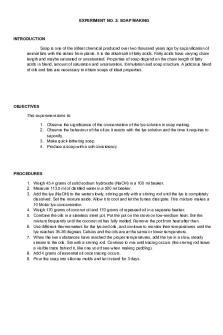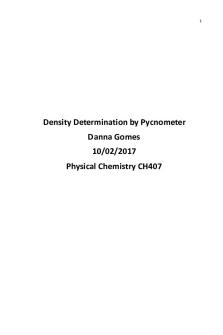Industrial Laboratory Report Sheet PDF

| Title | Industrial Laboratory Report Sheet |
|---|---|
| Author | Anonymous User |
| Course | Chemical Engineering |
| Institution | University of St. La Salle |
| Pages | 2 |
| File Size | 50.5 KB |
| File Type | |
| Total Downloads | 60 |
| Total Views | 144 |
Summary
This report is about Soap Making. The objectives and conclusions as well as the procedures on how to make a soap is included....
Description
EXPERIMENT NO. 2: SOAP MAKING
INTRODUCTION Soap is one of the oldest chemical produced over two thousand years ago by saponification of animal fats with the ashes from plants. It is the alkali salt of fatty acids. Fatty acids have varying chain length and maybe saturated or unsaturated. Properties of soap depend on the chain length of fatty acids in blend, amount of saturation and unsaturation, formulation and soap structure. A judicious blend of oils and fats are necessary to obtain soaps of ideal properties.
OBJECTIVES This experiment aims to: 1. Observe the significance of the concentration of the lye solution in soap making. 2. Observe the behaviour of the oil as it reacts with the lye solution and the time it requires to saponify. 3. Make quick lathering soap. 4. Produce a soap with a soft consistency
PROCEDURES 1. Weigh 45.4 grams of solid sodium hydroxide (NaOH) in a 100 ml beaker. 2. Measure 113.5 ml of distilled water in a 500 ml beaker. 3. Add the lye (NaOH) to the water slowly, stirring gently with a stirring rod until the lye is completely dissolved. Set the mixture aside. Allow it to cool and let the fumes dissipate. This mixture makes a 10 Molar lye concentration. 4. Weigh 170 grams of coconut oil and 170 grams of rapeseed oil in a separate beaker. 5. Combine the oils in a stainless steel pot. Put the pot on the stove on low-medium heat. Stir the mixture frequently until the coconut oil has fully melted. Remove the pot from heat after then. 6. Use different thermometers for the lye and oils, and continue to monitor their temperatures until the lye reaches 35-36 degrees Celsius and the oils are at the same or lower temperature. 7. When the two substances have reached the proper temperatures, add the lye in a slow, steady stream to the oils. Stir with a stirring rod. Continue to mix until tracing occurs (the stirring rod leave a visible trace behind it, like one you’d see when making pudding). 8. Add 4 grams of essential oil once tracing occurs. 9. Pour the soap into silicone molds and let it stand for 3 days.
OBSERVATIONS 1. We have decided to make a 10 Molar lye concentration for faster saponifaction process. It took about 10 minutes for the solid sodium hydroxide to dissolve in distilled water completely. As the lye was added to the water, it heated up and release fumes. 2. The oils used in the experiment are coconut oil and rapeseed oil. They are both equal in amount and have a clear yellowish color. As they were mixed with the lye solution, it took about 2 hours before the tracing happened. The tracing observed by the group is not perfectly like the one being described in the procedures. 3. After 3 days of observations, the resulting soap bubbled quickly as it was wet off with water. 4. The soap has a soft texture and the smell of the vanilla essential oil added to it remained evident.
COMPUTATIONS...
Similar Free PDFs

Lab 1 - Laboratory Report
- 10 Pages

Laboratory+report+1-4
- 11 Pages

Laboratory 11 - Lab Report
- 3 Pages

Laboratory report - aspirin
- 8 Pages

Laboratory Report 1 SKO3023
- 30 Pages

Laboratory Report Rubric
- 2 Pages
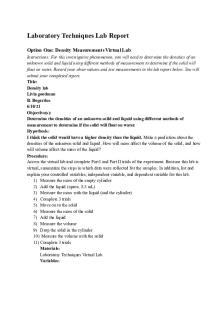
Laboratory Techniques Lab Report
- 4 Pages

LABORATORY REPORT EXPERIMENT 5
- 6 Pages

Laboratory report for BIO
- 4 Pages
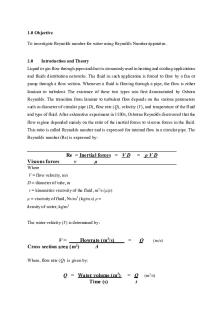
Reynold\'s Number Laboratory Report
- 11 Pages
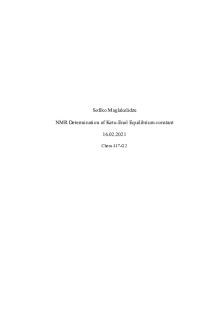
NMR Laboratory Report
- 17 Pages

Experiment 23 laboratory report
- 7 Pages
Popular Institutions
- Tinajero National High School - Annex
- Politeknik Caltex Riau
- Yokohama City University
- SGT University
- University of Al-Qadisiyah
- Divine Word College of Vigan
- Techniek College Rotterdam
- Universidade de Santiago
- Universiti Teknologi MARA Cawangan Johor Kampus Pasir Gudang
- Poltekkes Kemenkes Yogyakarta
- Baguio City National High School
- Colegio san marcos
- preparatoria uno
- Centro de Bachillerato Tecnológico Industrial y de Servicios No. 107
- Dalian Maritime University
- Quang Trung Secondary School
- Colegio Tecnológico en Informática
- Corporación Regional de Educación Superior
- Grupo CEDVA
- Dar Al Uloom University
- Centro de Estudios Preuniversitarios de la Universidad Nacional de Ingeniería
- 上智大学
- Aakash International School, Nuna Majara
- San Felipe Neri Catholic School
- Kang Chiao International School - New Taipei City
- Misamis Occidental National High School
- Institución Educativa Escuela Normal Juan Ladrilleros
- Kolehiyo ng Pantukan
- Batanes State College
- Instituto Continental
- Sekolah Menengah Kejuruan Kesehatan Kaltara (Tarakan)
- Colegio de La Inmaculada Concepcion - Cebu
